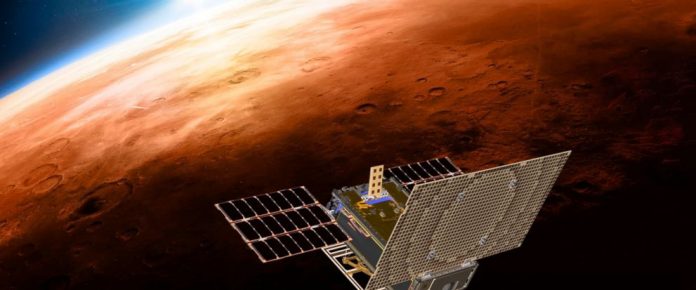A pair of briefcase-sized Nasa spacecraft have been lost after they flew past Mars.
The two robots – collectively known as Marco and nicknamed EVE and WALL-E – have flown so deep into space that the space agency is now unable to reach them, engineers said. It is unlikely the pair will ever be heard from again.
It has been more than a month since the robots were last heard from and they are now millions of miles beyond the red planet.
But Nasa considers the very fact it could talk to them at all a major success. The two craft pushed up against the limits of experimental technology, they say, and helped prove concepts that could allow such tiny robots to venture even more deep into space.
MarCO was th first interplanetary mission to use a class of small spacecraft known as CubeSats. Together, the pair worked as communications relays during the landing of InSight, a Nasa rover that dropped down around New Year and will be delving deep into Mars’s surface.
The two spacecraft were able to beam back data during the descent of the lander in near real-time, and sent back the stunning first images that were taken by InSight. The craft even did some science of their own: WALL-E took its own photos, and EVE did some simple radio science.
Because the technology was experimental, Nasa weren’t relying on either of the CubeSats working at all. If they had broken on their way – as engineers suspected they might – the data would still have been sent back but it would have taken much longer to receive it.
After their work was done at Mars, they carried on off into space. WALL-E hasn’t sent a message since 29 December, and is thought to be more than a million miles past Mars; EVE is even further away, at about two million miles, and hasn’t spoken to Nasa since 4 January.
Researchers don’t know exactly why the pair have lost touch. WALL-E has a leaky thruster and might be wobbling so that it can’t send commands. The sensors that allow them to charge their batteries from the sun might also have broken.
They will continue flying away from Earth as February goes on, making sending any data ever more difficult and so meaning that Nasa don’t expect to ever hear back.
“This mission was always about pushing the limits of miniaturized technology and seeing just how far it could take us,” said Andy Klesh, the mission’s chief engineer at JPL. “We’ve put a stake in the ground. Future CubeSats might go even farther.”
Nasa hopes to use the same technology – which allows spacecraft to be launched cheaply and easily – to venture off elsewhere in the solar system in future missions.
“There’s big potential in these small packages,” said John Baker, the MarCO program manager at JPL. “CubeSats – part of a larger group of spacecraft called SmallSats – are a new platform for space exploration that is affordable to more than just government agencies.”








